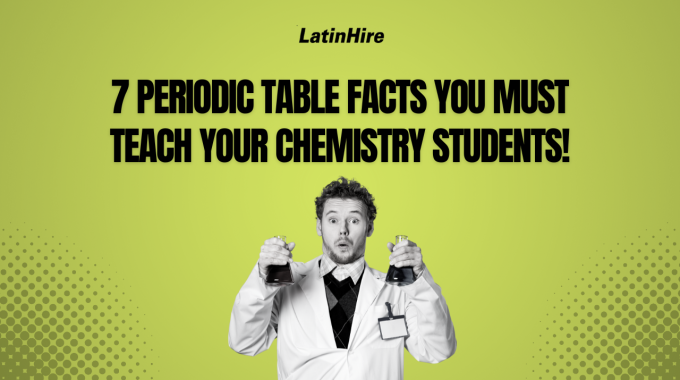Hydrocarbons form the backbone of organic chemistry, and understanding how to name and draw them…

7 Periodic Table Facts You Must Teach Your Chemistry Students!
The periodic table is the most important table in scientific history. It serves as the foundation of our understanding of the material world and provides a useful roadmap for scientists and chemistry students around the globe.
The history and organization of the periodic table is fascinating. If you teach chemistry or enjoy learning chemistry, here are seven facts about the periodic table that all students must know!
Fact #1: Elements are organized according to physical and chemical properties.
Do you enjoy playing card games like Solitaire? The organization of the periodic table is similar to a game of sorting cards. Rather than organizing cards according to numbers and suits, the periodic table organizes elements into increasing atomic numbers and repeating patterns of similar properties.
By knowing the location of an element in the periodic table, you can predict its properties such as structure, mass, electron configuration, reactivity and many more. Elements in the same group (vertical column) have the same number of valence electrons, which are electrons in the outermost energy level while elements in the same period (horizontal column) have the same number of energy levels.
Fact #2: Dmitri Mendeleev correctly predicted the existence of elements that weren’t discovered yet during his time.

Although Dmitri Mendeleev wasn’t the first scientist to create a version of the periodic table, he is credited for organizing the elements into what most closely resembles the modern day periodic table. By arranging the elements according to their atomic mass, he was able to notice patterns of repeating properties and grouped those elements together.
When Mendeleev finished his version of the periodic table, there were many gaps for elements that were not yet discovered. By analyzing the patterns, he was able to correctly predict the properties of those missing elements. It baffled the scientific community when those elements were discovered years later with the exact properties that Mendeleev described!
Fact #3: The staircase on the right side of the periodic table splits the metals and nonmetals.

To quickly determine if an element is metal or nonmetal, all you have to know is the location of a staircase at the right side of the periodic table. To the left of the staircase are metals (except for Hydrogen) and to the right of the staircase are nonmetals. The elements along the staircase are metalloids, which have properties of both metals and nonmetals!
Fact #4: The modern periodic table is organized by increasing atomic number, which represents the number of protons.
The major difference between Mendeleev’s version of the periodic table and the modern periodic table is that Mendeleev organized the elements according to atomic mass while the modern periodic table organizes elements according to atomic number. The atomic number represents the number of protons (positively charged), which also equals the number of electrons (negatively charged) in a neutral atom.
For example, the first element on the periodic table is Hydrogen which has one proton and one electron. The second element is Helium, which has two protons and two electrons. Every following element has one extra proton and one extra electron than the previous element.
Fact #5: You can calculate the number of neutrons by subtracting the atomic number from the mass number.
An atom’s mass comes from adding its protons and neutrons (neutral charge), which conveniently have equal mass. The electron’s mass can be discounted because it’s only about 1/2000th the mass of a proton or neutron. Therefore, mass number = # of protons + # of neutrons.
To obtain the mass number, you just have to round the atomic mass, which is found on the periodic table. Then, by subtracting the atomic number (= # protons) from the mass number, you will get the number of neutrons. For example, Carbon has an atomic number of 6, which means it has 6 protons. Its atomic mass is 12.01, so rounding gives 12 for its atomic mass.
Do the calculations:
12 (atomic mass) – 6 (atomic number / #protons) = 6 (number of neutrons)
Therefore, Carbon has 6 neutrons!

Fact #6: The atomic mass shown on the periodic table is the weighted average of all of the element’s isotopes.
Isotopes are atoms with the same number of protons but different number of neutrons. Since an atom’s mass comes from its protons and neutrons, if the number of neutrons are different, then the atomic mass of each isotope will be different. Thus, the atomic mass you see on the periodic table is actually the weighted average of all the isotopic masses.
For example, carbon has three isotopes: Carbon-12, Carbon-13, Carbon-14. On the periodic table, the atomic mass of carbon is 12.01. This number comes from the fact that Carbon-12 makes up 98.89% of all carbon in the world, Carbon-13 makes up 1.11% and Carbon-14 makes up 10^-12%, which is negligible.
To calculate the average atomic mass:
12 x 0.9889 + 13 x 0.0111 = 12.01
Fact #7: Atomic size decreases across the periodic table even though atomic number increases.

The atomic size is the distance from the nucleus to the outermost electrons. You may think that atomic size would increase as atomic number increases because more protons and neutrons are added. However, from left to right of the periodic table, the atomic size actually decreases!
This is due to an increase in nuclear charge, while the electron shielding stays the same. Nuclear charge is the total positive charge in the nucleus as a result of the protons. As more protons are added from left to right, the nuclear charge increases. Electron shielding refers to the blocking of attraction between the valence electrons and the nucleus due to all the inner-shell electrons. The electron shielding across a period stays the same as only valence electrons increase in number.
With a greater nuclear charge and same electron shielding, the attraction between the nucleus and the valence electrons becomes stronger, thus pulling them in and decreasing the size of the atom. (Going down the groups, atomic size increases as more energy levels are added.)
We hope you found these periodic table facts helpful for your chemistry class! What other facts about the periodic table do you teach your students? Share them in the comments below!



